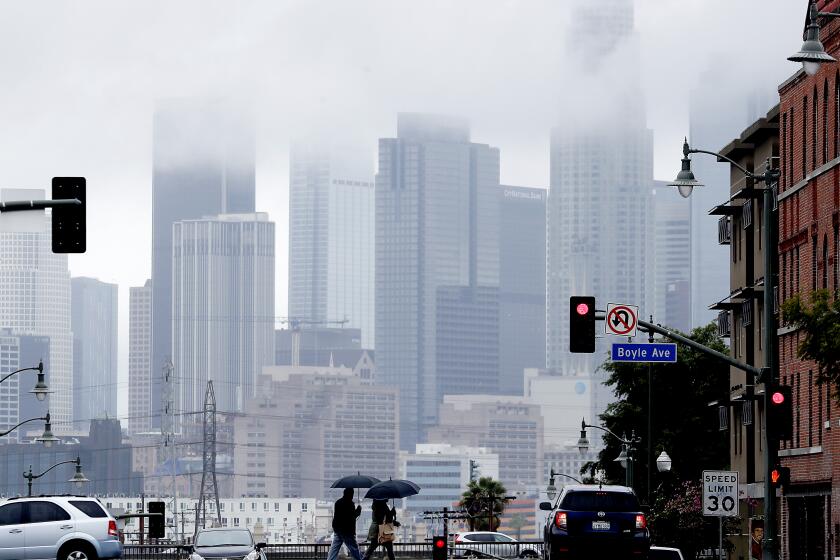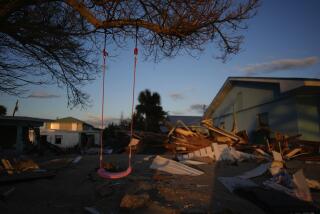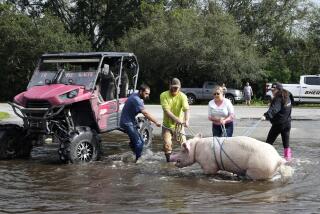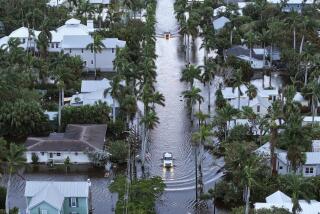Tropical Storm Eta floods already drenched Florida cities
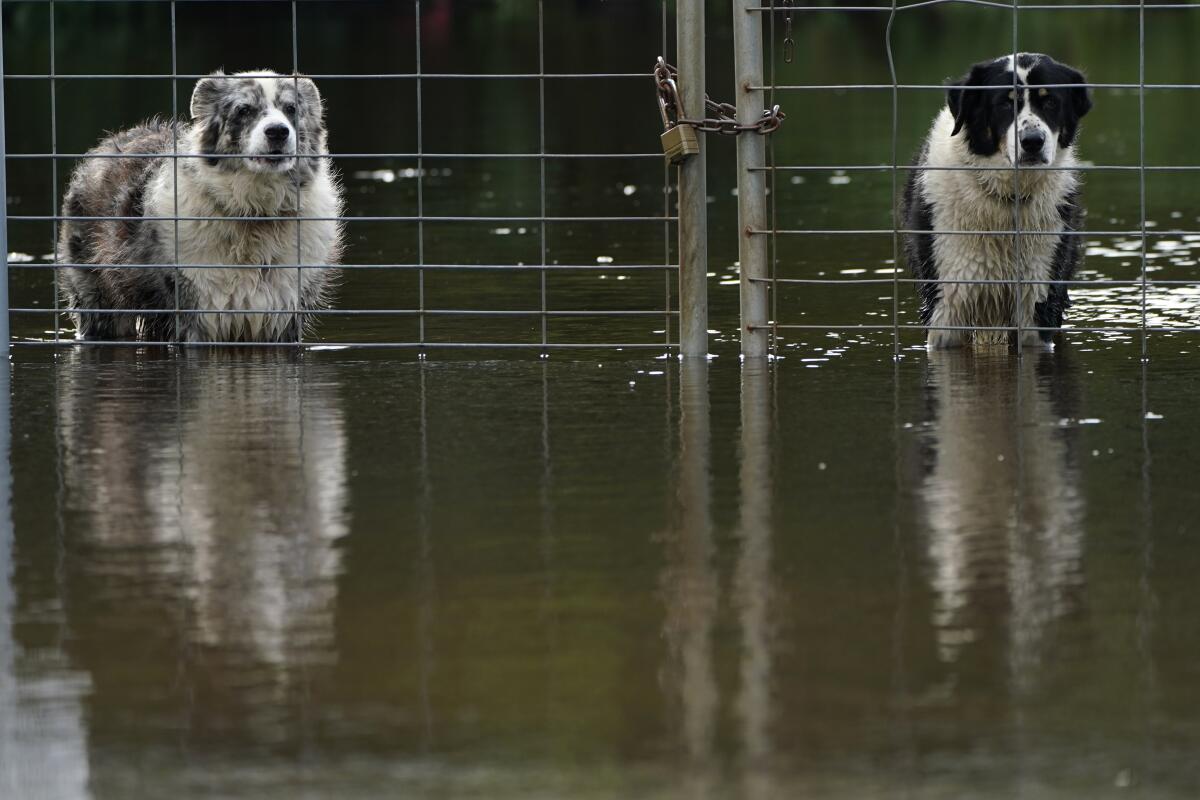
- Share via
FORT LAUDERDALE, Fla. — A deluge of rain from Tropical Storm Eta caused flooding Monday across South Florida’s most densely populated urban areas, stranding cars, flooding businesses, and swamping entire neighborhoods with fast-rising water that had no place to drain.
The system made landfall in the Florida Keys and posed a serious threat across South Florida, which was already drenched from more than 14 inches of rain last month.
“Never seen this, never, not this deep,” said Anthony Lyas, who has lived in his now-waterlogged Fort Lauderdale neighborhood since 1996. He described hearing water and debris slamming against his shuttered home overnight.
After striking Nicaragua as a Category 4 hurricane and killing nearly 70 people from Mexico to Panama, the storm moved into the Gulf of Mexico early Monday near where the Everglades meet the sea, with maximum sustained winds of 50 mph.
“It was far worse than we could’ve ever imagined, and we were prepared,” said Arbie Walker, a 27-year-old student whose Fort Lauderdale apartment was filled with 5 or 6 inches of water.
“It took us 20 minutes to navigate out of our neighborhood due to the heavy flooding in our area,” Walker added. Floodwaters also submerged half of his sister’s car.
A winter storm brought scattered rain showers to the Los Angeles area on Sunday and dumped snow on the mountains.
As much as 16 inches of rain damaged one of the state’s largest COVID-19 testing sites, at Miami-Dade County’s Hard Rock Stadium, officials said. Throughout the pandemic, it has been among the busiest places to get a coronavirus diagnosis. The site was expected to be closed until Wednesday or Thursday.
Eta hit land late Sunday as it blew over Lower Matecumbe, in the middle of the chain of small islands that form the Keys, but the heavily populated areas of Miami-Dade and Broward Counties bore the brunt of the fury.
It is the 28th named storm of a busy Atlantic hurricane season, tying the 2005 record for named storms. Hurricane season lasts until Nov. 30.
By Monday evening, the storm was about 155 miles west-southwest of the Dry Tortugas, moving southwest at 14 mph. It was expected to slow down further and strengthen overnight. Rain and wind were felt as far north as the Tampa Bay area.
Forecasters said the system could intensify again into a minimal hurricane as it slowly moves up the southwest Gulf Coast. It is just far enough offshore to maintain its strength while dumping vast amounts of water across the lower third of the Florida peninsula.
Fort Lauderdale Mayor Dean Trantalis called it a 100-year rain event.
“Once the ground becomes saturated, there’s really no place for the water to go,” Trantalis said. “It’s not like a major hurricane. It’s more of a rain event, and we’re just doing our best to ensure that the people in our community are being protected.”
City officials dispatched some 24 tanker trucks with giant vacuums to soak up water from the past few weeks. Some older neighborhoods simply do not have any drainage. The city also passed out 6,000 sandbags to worried residents over the weekend, but water seeped into homes and stranded cars in parking lots and along roadways.
“There was just so much rain in such a short amount of time there was nowhere for it to go,” said Fort Lauderdale resident Morgan Shattuck, who took photos of flooding on her street that showed swiftly moving water near the top of vehicles’ wheels.
As a ferocious hurricane bears down on South Florida, water managers desperately lower canals in anticipation of 4 feet of rain.
Randi Barry, 36, also woke up Monday to flooded streets outside her home in Fort Lauderdale, and joined her neighbors in helping people whose cars were stuck in high water.
“There are a lot of people with their doors open, getting furniture up to higher ground and trying to get water out of their homes,” Barry said. “Everyone is helping each other out a lot.”
A tractor-trailer was left dangling off the elevated Palmetto Expressway in Miami, the Florida Highway Patrol reported. The driver lost control on the wet, slick road and suffered minor injuries, CBS 4 in Miami reported.
“Please take this storm seriously,” urged Palm Beach County Emergency Management Director Bill Johnson. “Please don’t drive through flooded roadways.”
Miami-Dade County Mayor Carlos Gimenez said he was in frequent contact with county officials about the struggle to drain the flooded waters.
“In some areas, the water isn’t pumping out as fast as it’s coming in,” warned Miami-Dade Commissioner Jose “Pepe” Diaz.
Firefighters pulled a person from a car that had driven into a canal Sunday night in Lauderhill, north of Miami. The patient was hospitalized in critical condition, according to a statement from Lauderhill Fire.
In the Keys, the mayor ordered mandatory evacuations for mobile home and RV parks, campgrounds and other low-lying areas. School districts closed, saying the roads were already too flooded and the winds could be too gusty for buses to transport students. But the islands were spared any major damage, and officials expected shelters to close and schools to reopen by Tuesday.
Aside from a banyan tree that fell on a home and injured people inside, Key Largo was largely unscathed, Fire Chief Don Bock said.
Eta was not done yet with Cuba, just 90 miles south of Florida, where the storm continued to swell rivers and flood coastal zones. Some 25,000 people were evacuated with no reports of deaths, but rainfall continued, with total accumulations of up to 25 inches predicted. A tropical storm watch was in effect for parts of the island.
Nearly a week after Eta crashed ashore in Nicaragua, authorities from Panama to Guatemala have reported more than 100 dead and an even higher number of missing. Extensive flooding and landslides have affected hundreds of thousands of people in countries already struggling with the economic fallout of the pandemic.
More to Read
Sign up for Essential California
The most important California stories and recommendations in your inbox every morning.
You may occasionally receive promotional content from the Los Angeles Times.
